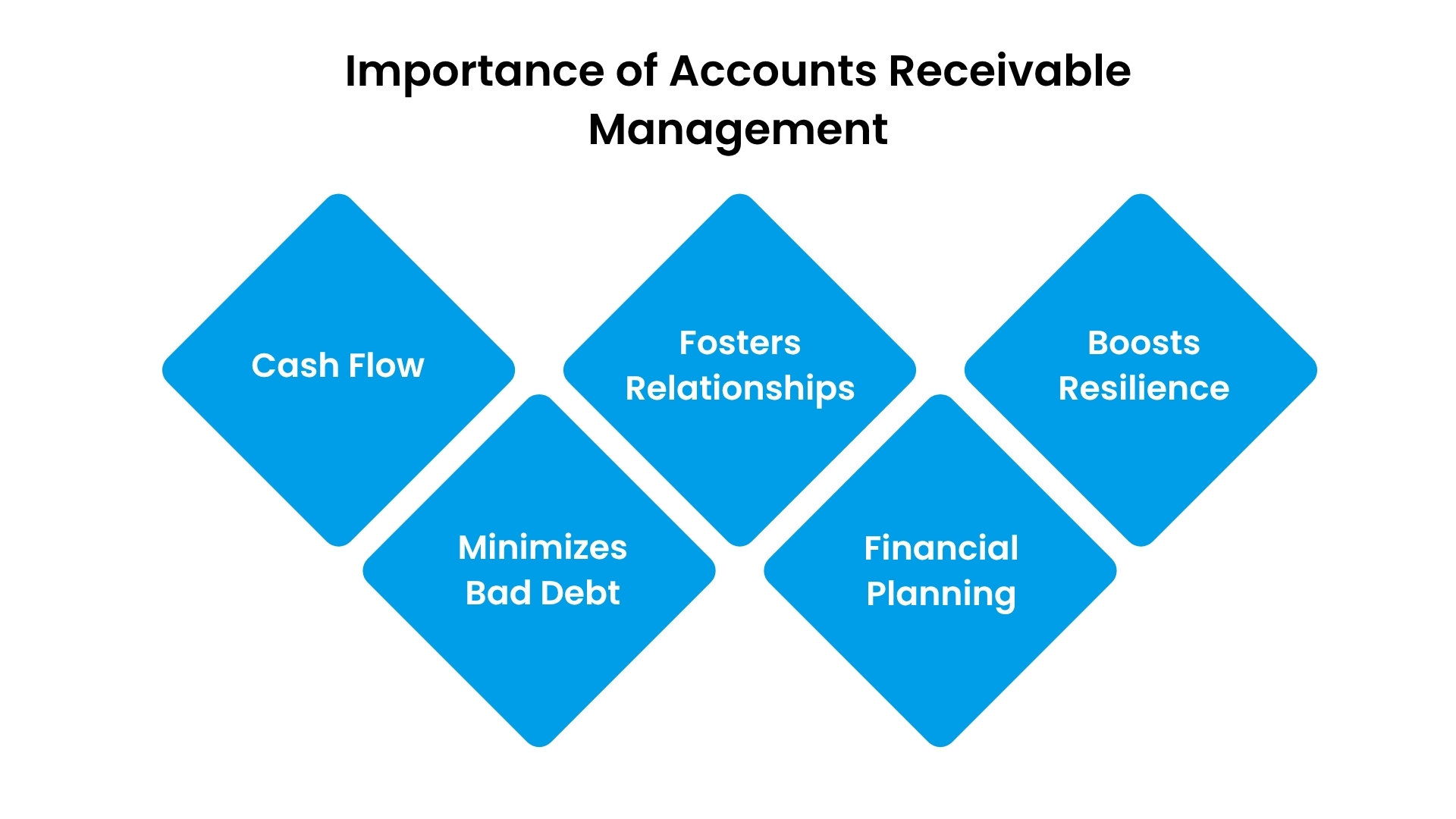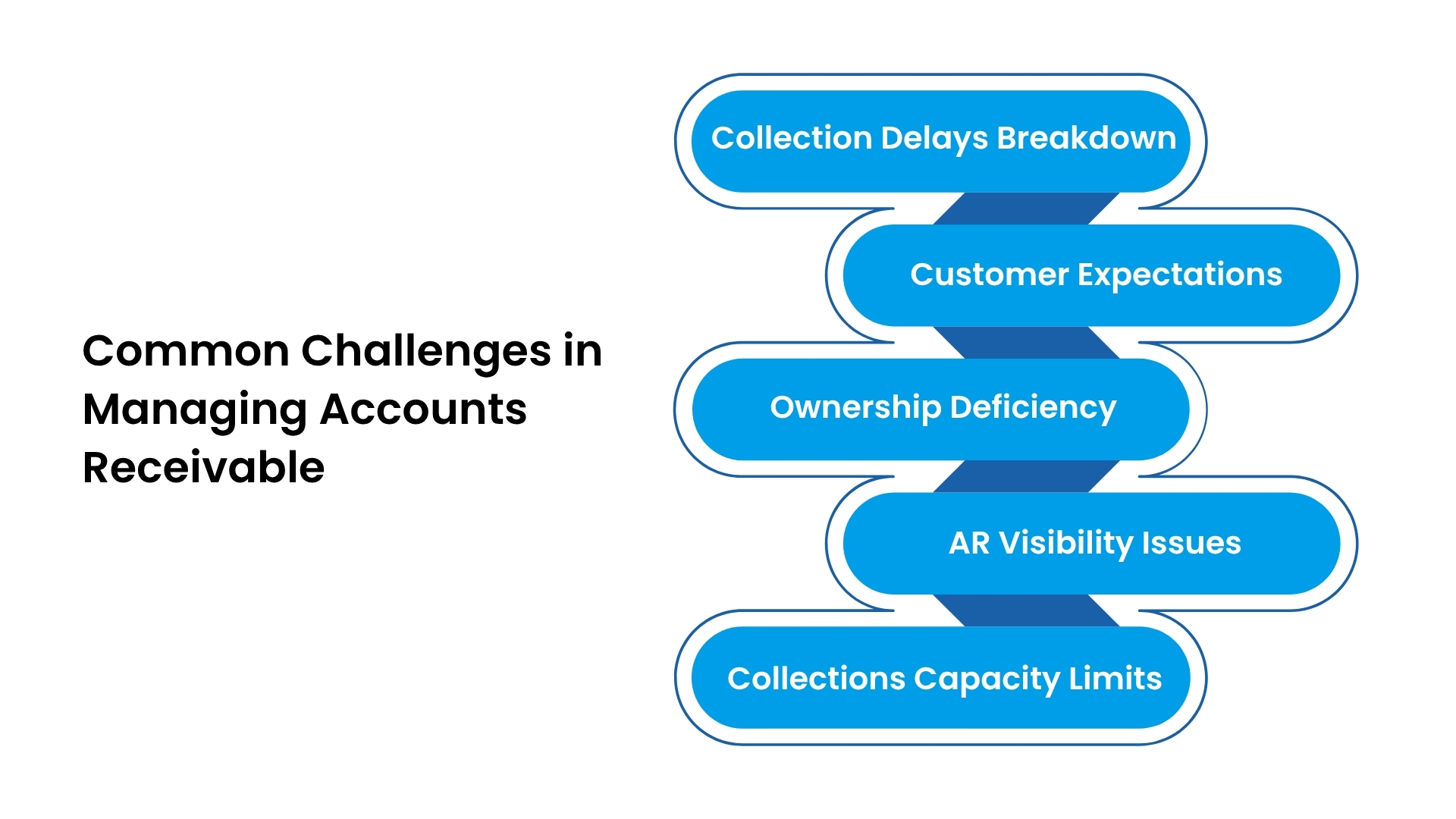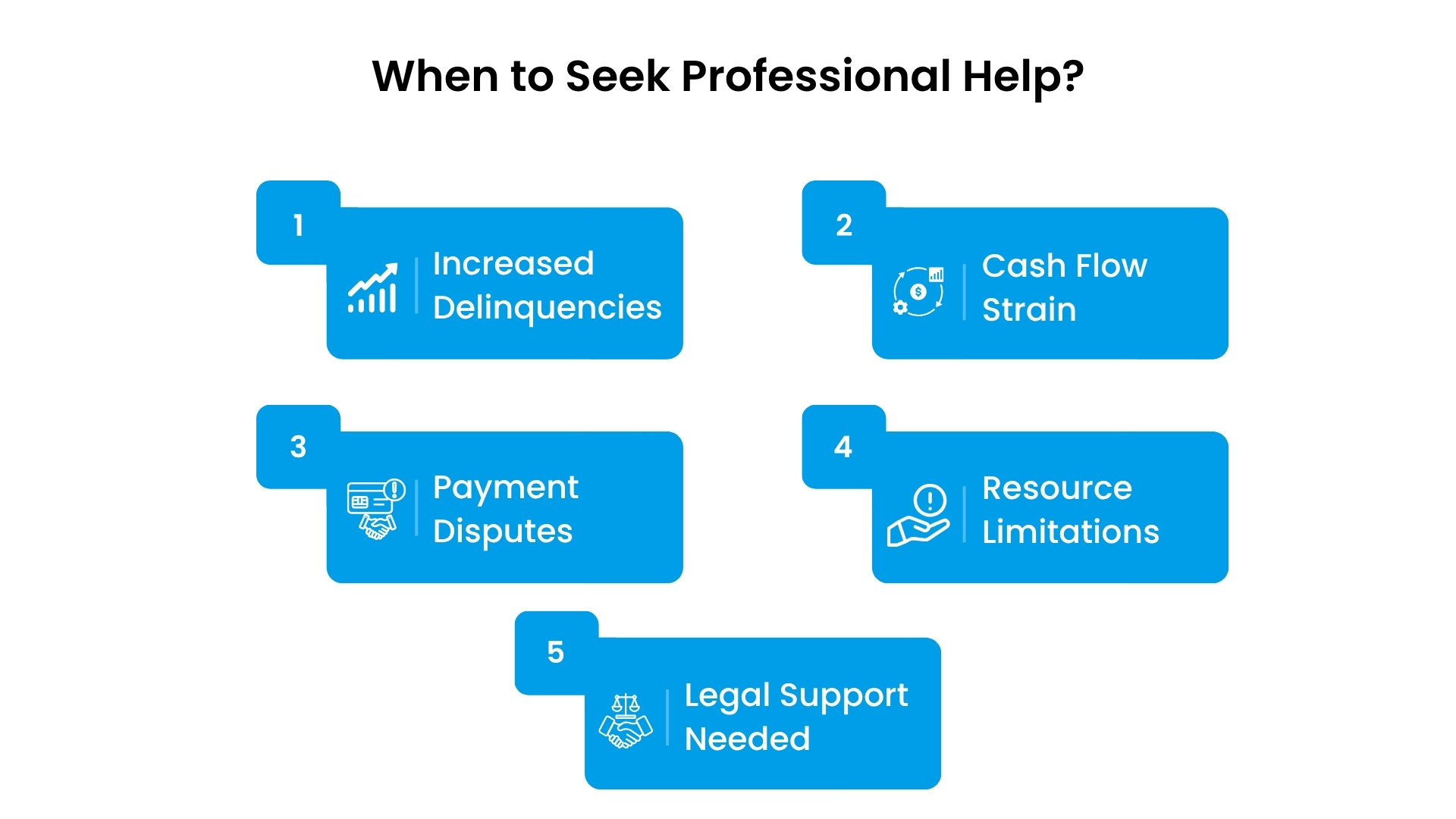Accounts Receivable Management Tips and Guide
Accounts Receivable Management Tips and Guide

Transform Your Financial Future
Contact UsManaging accounts receivable can be tough for many businesses. Studies show 81% of companies are seeing more delayed payments, with 50% reporting late-paying customers and 77% of AR teams falling behind on targets.
We understand how overwhelming it can feel when unpaid invoices disrupt your cash flow and create uncertainty in your operations. But with the right strategies, you can regain control, improve collections, and build a more resilient AR process.
This guide explores practical tips and insights to help you streamline accounts receivable management and overcome common challenges.
Key Takeaways
- Effective accounts receivable management is critical for improving cash flow and reducing the risk of bad debt.
- Implementing clear credit policies, monitoring KPIs, and refining payment terms can transform your AR process.
- Common challenges like late payments and resource constraints often require professional expertise to overcome.
- Tracking AR performance and applying proactive strategies helps businesses maintain financial stability.
What is Accounts Receivable Management?
Accounts receivable management is the process businesses use to track, collect, and manage money owed by customers for goods or services delivered on credit. It ensures timely payments, reduces bad debts, and supports healthy cash flow.
Effective AR management involves setting clear credit policies, sending accurate invoices, following up on overdue accounts, and maintaining strong customer relationships. It is a critical function that directly impacts a company’s liquidity and financial stability.
Having defined accounts receivable management, we will next examine its crucial impact on your business’s financial health and long-term success to build a foundational understanding before practical tips.
Why Is Accounts Receivable Management Important for Your Business?

Studies show that 9% of all B2B credit transactions eventually turn into uncollectible losses. The longer payments remain outstanding, the harder they are to recover. Only about 10% of invoices older than 12 months ever get paid.
This makes strong receivables management necessary. Without it, even profitable companies can face liquidity issues and mounting financial stress. These are a few reasons why you should invest in solid accounts receivable management strategies:
- Improves Cash Flow Stability: Consistent collections ensure your business has the funds needed to cover operating costs and invest in growth.
- Reduces Bad Debt Risk: Proactive AR processes help identify delinquent accounts early and prevent revenue losses from uncollectible debts.
- Supports Strong Relationships: Clear communication and fair policies maintain trust, making customers more likely to pay on time.
- Enhances Financial Planning: Accurate tracking of receivables provides better visibility for forecasting and budgeting.
- Strengthens Business Resilience: A healthy AR system helps your company through economic downturns and unexpected financial challenges.
With the importance of receivables management clear, let us now explore practical tips to help you improve your process and achieve faster, more reliable collections.
Suggested Read: How FinTech Is Transforming Debt Collection in 2025
Essential Accounts Receivable Management Tips
Efficient accounts receivable practices directly improve cash flow by reducing payment delays and minimizing bad debt, ensuring smoother business operations. Here are key tips to strengthen your AR process.
- Establish Clear Credit Policies
Your credit terms are the foundation of a healthy AR process. Without them, you risk extending credit to customers who cannot or will not pay on time.
Why It Matters: Poor credit decisions lead to chronic late payments and higher write-offs.
Common Mistake: Offering uniform terms to all customers without assessing risk levels.
What To Do:
- Define eligibility criteria based on payment history and creditworthiness.
- Set appropriate credit limits for new and high-risk customers.
- Communicate terms (e.g., Net 30, early payment discounts) upfront and reinforce them on every invoice.
- Send Accurate and Timely Invoices
Errors or delays in invoicing are a major cause of payment disputes and customer frustration.
Why It Matters: Even a small mistake, like an incorrect PO number, can trigger weeks of payment delays.
Common Mistake: Holding invoices until the month-end batch runs.
What To Do:
- Issue invoices immediately after delivery of goods or services.
- Double-check amounts, dates, and customer details for accuracy.
- Use digital invoicing platforms for faster delivery and real-time tracking.
- Monitor Accounts Regularly
Proactive monitoring helps you catch potential delinquencies early—before they impact cash flow.
Why It Matters: Overdue accounts tend to age into bad debt quickly if left unchecked.
Common Mistake: Only reviewing aging reports monthly instead of weekly.
What To Do:
- Review aging reports weekly to spot accounts slipping behind.
- Track KPIs like Days Sales Outstanding (DSO) and % of receivables over 60 days.
- Follow up the moment an account goes past due—do not wait for 30+ days.
- Automate Routine Processes
Automation reduces manual errors and ensures customers receive consistent reminders.
Why It Matters: Relying on staff to remember follow-ups leads to uneven collection efforts.
Common Mistake: Using generic one-size-fits-all reminders that customers tend to ignore.
What To Do:
- Invest in AR software that automates reminders, payment tracking, and reporting.
- Offer online payment portals to make paying as simple as possible.
- Customize reminder cadences for different customer segments—friendly nudges for reliable payers, firmer tones for chronic late payers.
- Strengthen Customer Communication
Strong relationships make payment conversations easier and reduce conflicts.
Why It Matters: Customers are more likely to prioritize paying vendors who communicate clearly and treat them professionally.
Common Mistake: Only contacting customers when they are already overdue.
What To Do:
- Send friendly reminders a few days before due dates to stay top of mind.
- Handle late payments with professionalism and empathy; offer payment plans where reasonable.
- Document all interactions so your team stays aligned and avoids miscommunication.
To make these tips sustainable, you need a solid AR framework. Let us explore how to build an effective accounts receivable management process that supports long-term success.
Suggested Read: How to Calculate and Improve Days in Accounts Receivable (A/R)
Building an Effective Accounts Receivable Management Process

A strong AR process ensures payments flow into your business predictably and efficiently. With clear roles, defined workflows, and smart tools, you can reduce overdue accounts and strengthen financial stability. Let us break this down into actionable steps:
- Define Roles and Responsibilities
Clear accountability within your AR team prevents confusion and missed follow-ups.
- Assign ownership for each account by designating team members to monitor invoices, send reminders, and handle disputes.
- Use a shared AR dashboard to show who owns each task and when the next action is due. This prevents blame-shifting and ensures visibility across the team.
- Establish a chain of escalation for accounts that are overdue. For instance, the AR specialist sends reminders, the AR manager handles disputes, and the finance head intervenes for high-value overdue accounts.
- Review team roles quarterly as your business grows or as AR complexity increases. Reassign responsibilities when bottlenecks emerge.
- Standardize Your AR Workflow
A standardized process reduces errors and creates a predictable experience for both customers and your team. Develop a step-by-step AR policy covering invoice issuance, payment terms, follow-ups, escalation, and handover to collections.
- Set clear timelines for reminders:
- First reminder: 7 days past due (friendly email or SMS).
- Second reminder: 15 days past due (firmer tone, offer payment options).
- Third reminder: 30 days past due (phone call + formal letter).
- Use reminder templates for emails, SMS, and letters. For example:
- Email subject: “Your Invoice #12345 – Friendly Reminder”
- Body: “We noticed your payment of $X due on [date] is outstanding. Please make the payment by [new date] to avoid late fees.”
- For internal coordination, set calendar alerts or Slack notifications to ensure timely action by staff.
- Integrate Technology and Tools
Many businesses use AR tools, but few integrate them well. The goal is to improve visibility, insight, and timely action. A well-integrated system keeps your team informed and your processes proactive.
- Look for AR tools that sync seamlessly with your invoicing system and CRM. This ensures customer data, payment histories, and communications are all in one place.
- Choose platforms that offer real-time visibility into aging accounts and Days Sales Outstanding (DSO) so you can act on problem areas before they escalate.
- Set up alerts to flag anomalies, like a historically reliable client suddenly missing payments. These early warnings help you intervene before accounts grow stale.
- Use tools that send customizable reminders based on customer behavior and account type, not generic one-size-fits-all messages. For instance, a VIP client may get a phone call, while a small account receives an automated email.
Pro Tip: Pair AR software with predictive analytics to forecast late payments and adjust terms proactively.
- Set Metrics for Performance Monitoring
Metrics are only helpful if they drive action. Tie your KPIs to regular review cycles and use the insights to launch improvement sprints within your AR team. This ensures that you are tracking numbers and also fixing what slows down cash flow.
Here are some key metrics to monitor:
- Days Sales Outstanding (DSO): Measures the average time it takes to collect receivables.
- Percentage of Receivables 60+ Days Overdue: Highlights aging accounts that may soon require escalation.
- Collection Success Rate by Customer Segment: Indicates which customer groups consistently pay on time and which require more stringent terms.
- Percentage of AR Collected Without Escalation: Tracks the effectiveness of your early-stage collection efforts.
After analyzing these KPIs, ask hard questions to trigger action:
- Are our payment terms too lenient or unrealistic for certain customer types?
- Are specific sales reps or clients consistently dragging down our metrics?
- Do we need external support, like a collection agency, for chronic non-payers?
Review these metrics monthly or quarterly. Pair them with improvement sprints in the form of targeted, time-bound initiatives to fix bottlenecks or test new strategies. For example, run a sprint to improve the collection rate for 60+ day accounts by implementing more personalized reminder sequences.
When your process runs smoothly, your team spends less time chasing overdue invoices and more time driving value. But how do you know if your AR process is truly working?
The answer lies in tracking the right KPIs. Let us look at the most important metrics to measure AR success.
Suggested Read: Financial Management Tools to Strengthen Debt Collection
Which Are the Most Important AR KPIs to Track?
Tracking the right KPIs (Key Performance Indicators) can help you gain insights into cash flow, customer payment habits, and overall financial health. These are a few important KPIs to track:
- Collection Effectiveness Index (CEI): Shows how effectively your team collects receivables over a specific period. A higher CEI means your collection strategies are working well.
- Accounts Receivable Turnover Ratio: Indicates how often your receivables are collected and replaced in a period. Higher turnover reflects efficient AR management.
- Percentage of Current Accounts Receivable: Reveals what portion of total receivables is not yet overdue. A higher percentage suggests fewer payment delays.
- Aging Schedule Analysis: Breaks down receivables by age (e.g., 30, 60, or 90 days overdue), highlighting potential problem accounts needing urgent attention.
Monitoring these KPIs regularly gives your business a clear picture of its AR performance. It helps you identify areas for improvement and take timely action to maintain a steady cash flow.
Despite implementing strong processes and metrics, businesses encounter common challenges in accounts receivable management; understanding these hurdles helps contextualize the need for adaptive strategies.
Common Challenges in Managing Accounts Receivable

Even well-designed AR systems can break down if the root causes of collection issues are not addressed. Late payments, workflow gaps, and poor visibility often signal deeper problems in process, people, or customer alignment. Let us diagnose these challenges and offer practical fixes.
- Process Breakdowns That Delay Collection
Many businesses lack a defined follow-up system, especially when small teams juggle multiple roles. This results in invoices being sent, but with no one owning the timeline for follow-up.
Red Flag: You rely on ad hoc reminders, and overdue accounts often go unnoticed until they are 30+ days late.
Quick Fix: Design a Tiered Follow-up Cadence. Friendly reminder at 7 days overdue, a firmer nudge at 15 days, and escalation at 30 days. Automate reminders where possible to ensure consistency without overloading staff.
- Misaligned Customer Expectations
Payment delays often stem from mismatches in expectations regarding due dates, invoice formats, or dispute resolution. When terms are not communicated upfront, customers are more likely to delay or contest charges.
Red Flag: You see repeated disputes over payment terms or customers asking for extensions after the due date.
Quick Fix: During onboarding, provide clients with clear payment terms, preferred payment methods, and contact details for queries. Use standardized templates for invoices and reminder emails to reinforce expectations.
- Lack of Internal Ownership
When no one on your team is explicitly accountable for collections, follow-ups can be inconsistent. This is common in businesses where AR responsibilities are shared loosely across departments.
Red Flag: Team members assume “someone else is following up,” and accounts slip through the cracks.
Quick Fix: Assign clear ownership of accounts using a shared AR dashboard. Display who owns each account, the current status, and the next action due date. This ensures transparency and prevents blame-shifting.
- Poor Visibility Into AR Health
Without real-time insights, it is hard to spot trends or prioritize high-risk accounts. Teams often react to problems instead of preventing them.
Red Flag: Leadership requests AR updates, but it takes hours to compile fragmented reports.
Quick Fix: Use AR software with a real-time dashboard showing aging schedules, DSO, and collection status. Set up weekly summary reports to keep your team and leadership informed.
- Limited Bandwidth for Collections
Small teams often lack the time to follow up effectively, especially with a growing number of overdue accounts. This leads to prioritizing only large balances while smaller accounts age unnoticed.
Red flag: Overdue accounts under $1,000 are often written off because no one has time to pursue them.
Quick fix: Automate reminders for lower-value accounts and focus human efforts on high-value or high-risk debtors. Consider outsourcing chronic non-payers to a third-party agency when internal resources are stretched.
Proactive receivables management reduces the risk of revenue loss and financial strain. One powerful way to overcome many of these challenges lies in refining your payment terms.
Let us explore how better payment terms can reshape your AR process for lasting results.
How Can Better Payment Terms Reshape Your AR Process?
Payment terms often fail when they are unclear, overly flexible, or not communicated consistently. Customers end up confused about due dates or assume leniency because enforcement has been lax in the past.
Many businesses struggle because their terms are vague, unenforced, or poorly aligned with customer realities. Top-performing businesses treat payment terms as a living part of their AR process, not a static document.
- Clear Terms Set Customer Expectations
Ambiguous or overly flexible terms lead to disputes and delayed payments. Clear, firm terms set boundaries that customers respect. Top performers pair Net 30 terms with late payment penalties (e.g., 1.5% per month) and early payment discounts (e.g., 2% if paid in 10 days). This gives customers both a reason to pay early and a consequence for paying late.
What You Can Do:
- Add late fee clauses to contracts where applicable and enforce them consistently.
- Highlight payment terms on every invoice and reminder, not just in the contract.
- Use automated reminders to reinforce expectations at 5, 10, and 15 days before due dates.
- Flexible Options Improve Payment Compliance
Rigid terms can backfire, especially during cash flow crunches for your customers. A little flexibility keeps relationships intact and payments flowing. Top performers offer phased invoicing for large projects and multiple payment methods (ACH, credit cards, digital wallets) to remove friction.
What You Can Do:
- Provide early payment discounts for small accounts and phased payment plans for large ones.
- Set up online portals that accept various payment options to make paying as easy as possible.
- Monitor customer behavior and adjust terms only for those with a strong payment history.
- Enforcing Terms Strengthens AR Discipline
Even strong terms mean little without enforcement. Inconsistent follow-ups create a culture where late payment becomes the norm. Top performers stick to their reminder cadence and escalate overdue accounts at defined intervals. Over time, their customers learn these businesses take AR seriously.
What You Can Do:
- Establish a tiered follow-up schedule:
- Friendly reminder 5 days before the due date.
- Firm reminder 3 days after the due date.
- Escalation notice at 15 days overdue.
- Use templates for email, SMS, and phone scripts to ensure consistency across the team.
- Escalate chronic late payers to external support (like AR management firms) after 60–90 days overdue.
When overdue accounts pile up despite your best efforts, it may be time to seek professional help. Here is how expert support can ease the burden and recover lost revenue.
When to Seek Professional Help?

Even with strong accounts receivable strategies in place, there are situations where bringing in outside expertise can make a significant difference. Knowing when to seek professional help can save time, preserve customer relationships, and recover revenue more effectively.
Look for these signs to know when to call in experts:
- Rising Volume of Overdue Accounts: When late payments keep increasing despite internal efforts.
- Cash Flow Pressures Impacting Operations: If delayed collections are affecting your ability to cover expenses or invest in growth.
- Frequent Customer Disputes Over Payments: When disputes and negotiations consume too much of your team’s time.
- Limited Internal Resources: If your team lacks the time, tools, or expertise to manage collections effectively.
- Need for Legal or Compliance Support: If pursuing delinquent accounts requires handling complex regulations.
Recognizing these warning signs early allows businesses to take proactive steps. Engaging professionals ensures collections are handled efficiently and with the right balance of firmness and customer care.
This is where The Forest Hill Management comes in. They provide the expertise and resources to manage your accounts receivable challenges with precision and professionalism, as discussed in the next section.
Simplify Your Receivables With The Forest Hill Management by Your Side
Chasing overdue accounts, managing inconsistent follow-ups, and staying on top of regulations can drain your team’s time and energy. The Forest Hill Management can step in as an extension of your business, helping you fix these gaps so you can focus on growth and not just collections.
- Turn Late Payments Into Reliable Cash Flow
Late payments often happen because reminders are missed or customers are not held accountable. The Forest Hill Management uses proven follow-up systems and skilled negotiators to recover unpaid invoices while preserving customer relationships. Your team can stop worrying about awkward calls and focus on core operations.
- Custom Strategies for Your Unique Challenges
A one-size-fits-all approach rarely works in AR. The Forest Hill Management analyzes your customer base, payment trends, and industry practices to design customized collection plans. Whether you struggle with chronic late payers or high invoice volumes, they create targeted strategies to improve recovery rates.
- Stay Compliant Without the Headache
Regulatory missteps in collections can be costly. With constantly changing laws, it is easy to make mistakes. The Forest Hill Management’s compliance-focused practices ensure that all recovery efforts adhere to federal and state regulations, thereby protecting your business from legal risks.
- Get Real-Time Insights to Stay in Control
Disorganized reporting leaves many businesses in the dark about their AR health. The Forest Hill Management provides advanced tools and dashboards that give you clear visibility into outstanding invoices, aging reports, and recovery metrics. You get actionable data to make smarter financial decisions.
The Forest Hill Management goes beyond traditional collections to offer a full suite of AR solutions. Their expertise helps businesses simplify receivables, reduce financial stress, and recover revenue efficiently.
Conclusion
Managing accounts receivable effectively is crucial for maintaining a stable cash flow and establishing a financially resilient business. Every step in the AR process contributes to smoother operations and stronger customer relationships. Yet, even with best practices in place, challenges such as late payments and resource constraints can persist, making professional support a valuable asset.
This is where The Forest Hill Management can make a difference. With professional debt recovery services, customized collection plans, and advanced reporting tools, they help businesses simplify receivables and recover outstanding payments more efficiently. Their expertise allows you to focus on growth while they handle the complexities of collections.
Take control of your accounts receivable today. Reach out to The Forest Hill Management and discover how our solutions can support your financial goals.
Frequently Asked Questions
1. What are the 5 C’s of accounts receivable management?
The 5 C’s are Character, Capacity, Capital, Conditions, and Collateral. They help evaluate customer creditworthiness, assess risks, and make informed decisions about extending credit to ensure timely payments and minimize bad debts.
2. What is the 10 rule for accounts receivable?
The 10 rule suggests following up within 10 days after an invoice’s due date. Quick action improves recovery rates, maintains cash flow, and reinforces payment expectations without straining customer relationships.
3. How to effectively manage accounts receivable?
Set clear credit policies, send accurate invoices promptly, monitor aging reports, automate reminders, and maintain positive customer communication. These steps help reduce overdue accounts, improve cash flow, and build a stronger financial foundation for your business.
4. What are the five steps to managing accounts receivable?
The five steps are defining credit terms, issuing accurate invoices, tracking receivables, following up on overdue payments, and reviewing performance regularly. Together, they create an organized process to minimize delays and strengthen cash flow management.
-p-500%20(1).png)